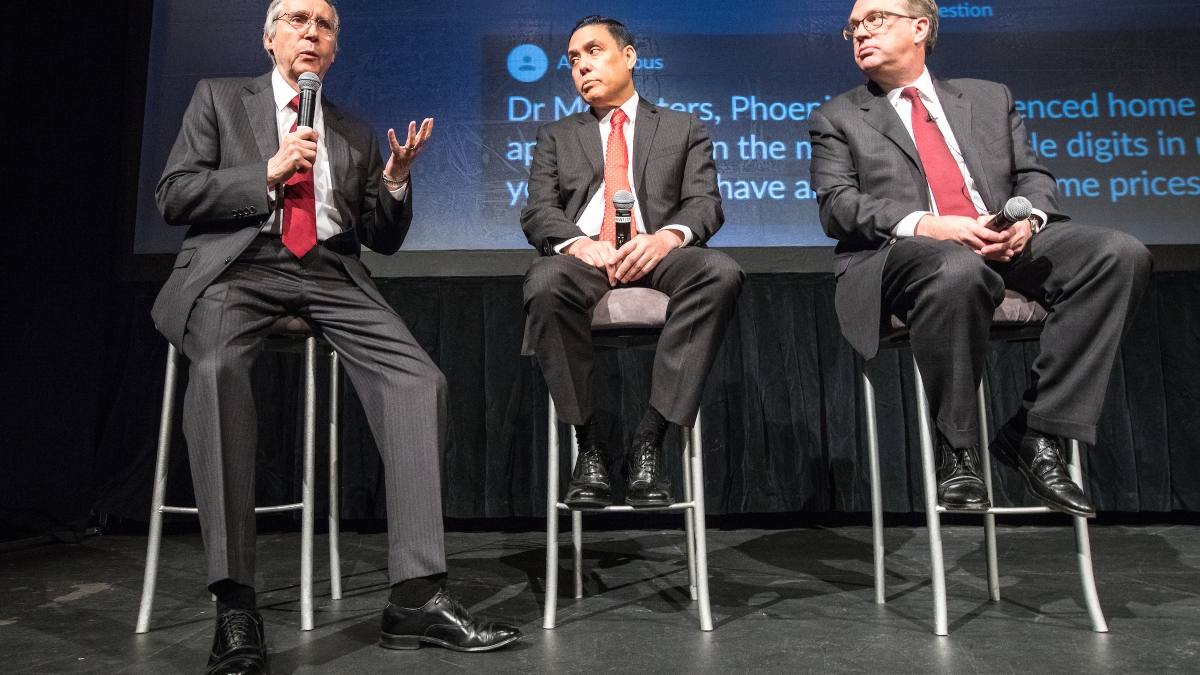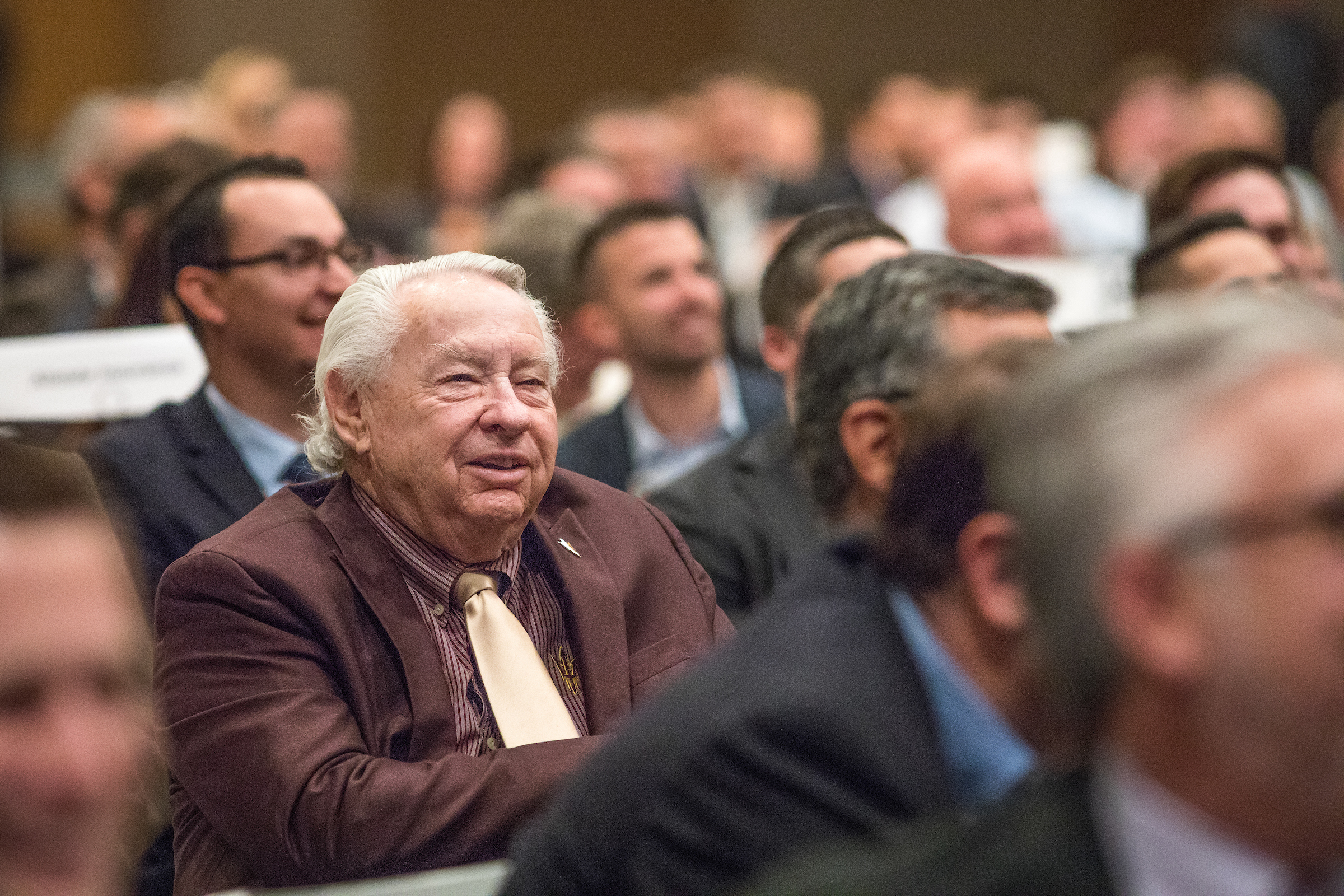An Arizona State University economist expects the state to continue attracting people from other states but said that additional population could put a strain on Arizona’s resources.
Lee McPheters discussed the outlook for Arizona at the 54th annual Economic Forecast Luncheon on Wednesday, sponsored by the W. P Carey School of Business at ASU and JP Morgan Chase and Co.
“We expect steady, sustainable but not spectacular growth — certainly better than most places,” said McPheters, research professor of economics in the W. P. Carey School of Business and director of the school's JPMorgan Chase Economic Outlook CenterMcPheters is editor of the Arizona Blue Chip Economic Forecast and the Western Blue Chip Economic Forecast newsletters, published monthly by the center..
“We’re close to a top 10 growth state but not in the top five.”
Health care, finance and food service are very strong industries in Arizona, he said. But one of the biggest drivers in the state’s economy is the 61,000 new residents who come from other states every year.
But the state must keep up with that population growth — which he forecasts will be 120,000 new people from domestic and international locations in 2018 — about a 1.7 percent increase.
“The Arizona Department of Transportation estimates that to meet the needs of population growth, the cost will be $100 billion. But our gas tax is the same as it was 25 years ago,” he said.
Among McPheters’ forecasts for next year:
More jobs: This was a caution area for McPheters, who said that in October 2017, Arizona added 32,000 jobs for the previous 12 months. That’s half as many as the 65,000 jobs added from October 2015 to October 2016.
“That comparison alone suggests job growth has slowed, and that bears watching,” said McPheters, who predicts 61,000 new jobs next year, although unemployment will likely decline tick down slightly to 4.2 percent.
“We think that 2 to 2.5 percent job growth is a new normal for the Arizona economy. It’s not going to be an era where we have the 4 percent job growth we had 20 years ago.”
In a strange twist, McPheters found that metro Phoenix added 51,000 new jobs in 2017, while statewide, the number of jobs added for the calendar year will likely be about 47,000. That’s because Tucson is losing jobs.
“That’s not good for the state or the economy,” he said.
Higher wages: McPheters forecasts average hourly wages will increase by about 4.5 percent, to $26.26, up from the $25.13 average of this year.
He noted that Arizona leads the nation in the growth of food-service jobs despite the increase in the minimum wage to $10 an hour in January.
More houses: Arizona’s housing industry continues to recover with a 15 percent increase in the number of single-family home permits forecast. That’s about 32,580 new houses — twice as many as the 16,189 new homes in 2012.
In the Phoenix area, McPheters expects the boom in multifamily construction to cool. He sees a 32 percent decline in permits for apartments, to about 6,883, for next year.
ASU alum Ed Sandidge and nearly 700 others listen at the Economic Forecast Luncheon in downtown Phoenix on Wednesday. Photo by Charlie Leight/ASU Now
McPheters said one area of concern is education.
“When you look at the drivers of business relocation, things have really changed. There was an era when the cost of doing business and the tax structure were always number one and two,” he said.
“In modern times, the answer is invariably quality and availability of labor, and right now Arizona has a somewhat lower proportion of college-educated persons. We’re lower than our competitors, in particular Colorado.
“We need to be sure that within the state we are growing people who can benefit the economy.”
Other speakers at the event were John Williams, president and CEO of the Federal Reserve Bank of San Francisco, and Anthony Chan, Chase’s chief economist.
Williams said that the national economy is in good shape and that the U.S. has essentially reached maximum employment, with an unemployment rate of about 4 percent.
“Even in a very strong economy, there’s always someone who’s not in a job, and the reality is that we’ll never get to zero,” he said.
Williams said the “misery index” is measured as the unemployment rate, about 4 percent, added to the inflation rate, which is now about 1.5 percent, for a misery index of 5.5 percent. He noted that the index was twice as high in 2011 and exceeded 20 percent in 1980.
Chan said that the current recovery is the third longest economic expansion in U.S. history, going back to 1900.
“When you look at economic expansions, the good news is that they don’t die of old age. You need some sort of a catalyst to end it,” he said, such as a housing bubble.
“The bottom line is I don’t see any catalyst, and that’s why I think this economic expansion can go on for two or three more years.”
For details on the JPMorgan Chase Economic Outlook Center, click here.
Top photo: ASU’s Lee McPheters (left) answers a question about the housing market as he, Anthony Chan (chief economist with Chase) and John Williams (head of the Federal Reserve Bank of San Francisco) speak at the 54th annual ASU/JPMorgan Chase Economic Forecast Luncheon in downtown Phoenix on Wednesday. The three gave studied reasons they believe local, national and international economies will have modest growth for the next few years, barring unforeseen events. Photo by Charlie Leight/ASU NowPhoto by Charlie Leight/ASU Now
More Arts, humanities and education

ASU instructor’s debut novel becomes a bestseller on Amazon
Desiree Prieto Groft’s newly released novel "Girl, Unemployed" focuses on women and work — a subject close to Groft’s heart.“I have always been obsessed with women and jobs,” said Groft, a writing…

‘It all started at ASU’: Football player, theater alum makes the big screen
For filmmaker Ben Fritz, everything is about connection, relationships and overcoming expectations. “It’s about seeing people beyond how they see themselves,” he said. “When you create a space…

Lost languages mean lost cultures
By Alyssa Arns and Kristen LaRue-SandlerWhat if your language disappeared?Over the span of human existence, civilizations have come and gone. For many, the absence of written records means we know…



